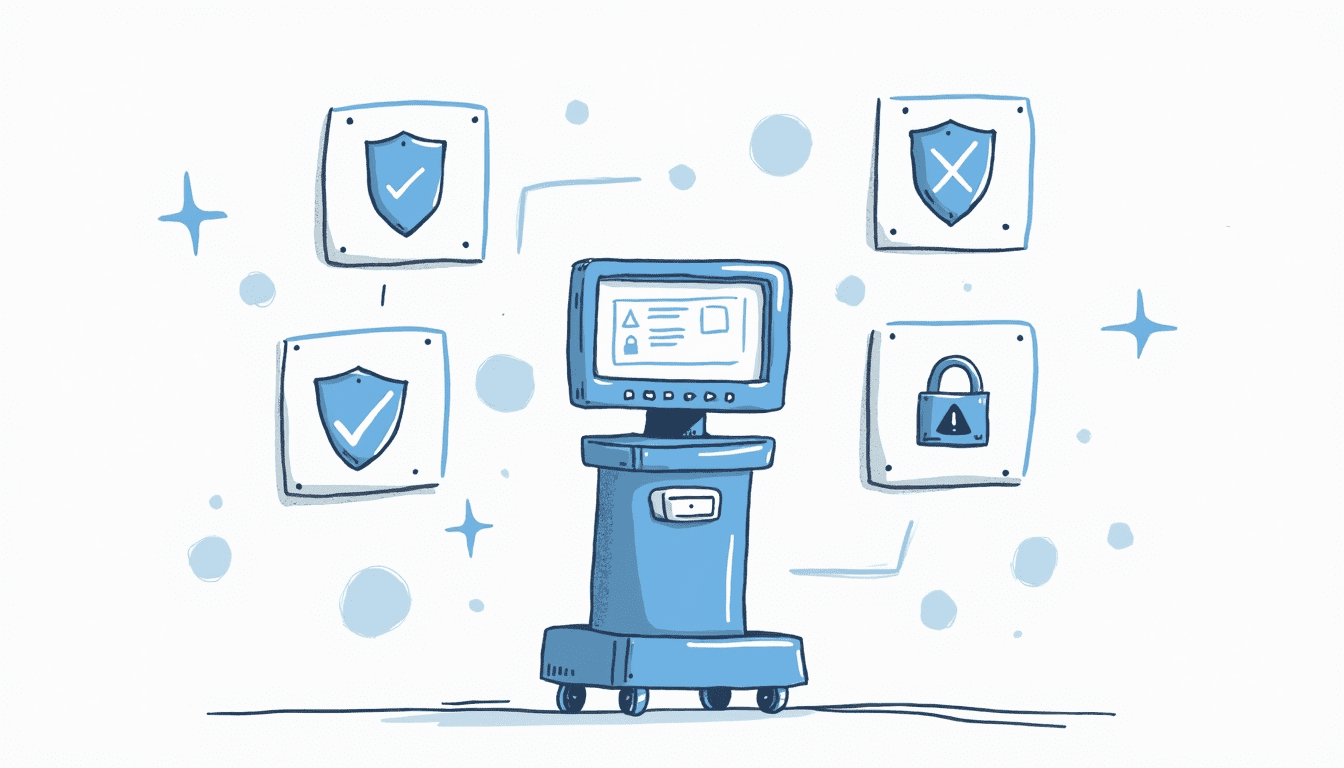Updated November 17, 2024
In today’s healthcare landscape, “safety” and “security” often intertwine, particularly when discussing medical devices. These devices have revolutionized patient care, but with innovation comes the need for clear understanding. Let’s delve into what these risks entail and how they differ.
Defining Safety and Security in the Context of Medical Devices
Before we explore safety and security in medical devices, we need to define what these terms mean in this context. Safety relates to the operational integrity of the device. A device is deemed safe if it performs as intended without causing undue patient harm.
On the other hand, security involves protecting medical devices from malicious interference. The implications of security breaches are dire, ranging from data theft to the manipulation of device functions. Simply put, safety is about ‘doing no harm,’ while security pertains to safeguarding devices from harm.
What is Safety in Medical Devices?
Safety encompasses various aspects of device performance. It refers to how well a medical device can function under normal conditions. Consider a pacemaker—it must provide appropriate pacing without causing adverse effects. The entire design must account for potential risks, from software to hardware.
Safety protocols need to be in place for when things go awry. Imagine a scenario where a device fails in the middle of a life-saving procedure. Alternative measures must be pre-established to ensure patient well-being. This includes comprehensive testing and validation processes during the device development phase, as well as ongoing monitoring once the device is in use. Regulatory bodies, such as the FDA, impose strict guidelines to ensure that manufacturers adhere to safety standards, involving extensive clinical trials and post-market surveillance to assess the device’s performance in real-world settings continuously.
What is Security in Medical Devices?
Security is like a fortress surrounding the medical device. The goal is to shield sensitive information and maintain operational integrity to prevent unauthorized access. This means robust encryption, user authentication, and continual monitoring for vulnerabilities.
To illustrate, think of a smart insulin pump. If hackers could gain entry, they could alter dosages or even stop delivery altogether. This is why constant vigilance and updates are necessary to maintain healthcare security. The cybersecurity landscape is ever-evolving, and as medical devices become more interconnected—often part of larger health information systems—the potential attack surfaces increase. Manufacturers must implement strong security measures during the design phase and engage in regular security audits and updates to address emerging threats. Additionally, educating healthcare providers about best practices for device security, such as maintaining secure networks and using strong passwords, is essential to creating a comprehensive defense strategy against cyber threats.
The Intersection of Safety and Security Risks
As we navigate safety and security, it’s essential to recognize how these risks can overlap. Both aspects must be prioritized in a medical device’s lifecycle. One cannot forsake the other; a device may be secure but unsafe, or vice versa.
For instance, a well-protected device might suffer from design flaws leading to safety hazards, while a perfectly designed device may have weak security protocols. Hence, vigilance becomes paramount at the intersection of safety and security.
How Safety and Security Risks Overlap
Let’s consider the example of a connected health device that monitors vital signs. If the data it collects is unsecure, malicious users could manipulate it, potentially resulting in incorrect treatments. Thus, patient safety is compromised not just by device malfunction but also by security breaches.
Points of overlap create a unique challenge for manufacturers. They must balance innovation with rigorous safety and security protocols, which is no small feat. The rapid pace of technological advancement in healthcare means that manufacturers often race against time to implement the latest features while ensuring that these innovations do not introduce new vulnerabilities. This balancing act requires a deep understanding of both the technical aspects of device development and the regulatory landscape governing medical technologies.
Unique Challenges at the Intersection of Safety and Security
Medical device manufacturers face increasing scrutiny at the crossroads of safety and security. Regulatory agencies, healthcare providers, and patients call for higher standards. Imagine tuning a piano while a concert is underway—practically impossible, right?
Developing for both safety and security often results in priorities and resource allocation conflicts. Sometimes, the pressure to bring a product to market may lead to incomplete assessments of either risk. This can spell trouble down the line. For example, a manufacturer might prioritize user-friendly interfaces and advanced functionalities at the expense of robust encryption methods, leaving the device vulnerable to cyberattacks.
As devices become more interconnected, the potential for a single point of failure increases, creating a domino effect that can jeopardize multiple systems simultaneously. This complexity necessitates a comprehensive approach to risk management that considers the individual device and its role within the larger healthcare ecosystem.
Distinguishing Between Safety and Security Risks
When addressing risks in medical devices, it is vital to distinguish between them. Safety and security are often discussed interchangeably, but failing to differentiate can lead to misconceptions. Let’s break it down further.
Critical Differences in Safety Risks
Safety risks are typically internal. They stem from device design, functionality, and usage. For example, a poorly designed surgical tool could malfunction, leading to severe injuries. Manufacturers must conduct extensive testing and validation to identify safety risks before devices hit the market.
A culture of safety must also be adopted, ensuring that healthcare practitioners are trained thoroughly on device usage. The consequences of neglecting safety protocols can be catastrophic—ask the folks who invented the first defibrillator!
The importance of post-market surveillance cannot be overstated. Once a medical device is in use, continuous monitoring is essential to detect any unforeseen safety issues that may arise over time. This includes gathering feedback from healthcare professionals and patients and analyzing data from adverse event reports. Such vigilance helps manufacturers make necessary adjustments and updates, ensuring that devices remain safe and effective throughout their lifecycle.
Differences in Security Risks
Conversely, security risks primarily arise from external sources. They can result from cyber-attacks, unauthorized access, or data breaches. For instance, a ransomware attack on a hospital’s network could cripple access to critical devices and patient information.
Understanding that security vulnerabilities exist outside the manufacturing process is essential. Cybersecurity constantly evolves; it requires ongoing assessment and adaptation of techniques to fend off new threats and attacks.
Integrating the Internet of Things (IoT) in healthcare has introduced additional layers of complexity to security risks. As more devices become interconnected, the potential attack surface expands, making it crucial for healthcare organizations to implement robust security measures. This includes encrypting sensitive data, regularly updating software, and conducting penetration testing to identify and mitigate vulnerabilities before malicious actors can exploit them. The stakes are high, as breaches can compromise patient privacy and disrupt critical healthcare services, highlighting the need for a proactive approach to security in the medical device landscape.
Mitigating Safety and Security Risks in Medical Devices
To safeguard both safety and security, proactive strategies must be implemented. These strategies should not be an afterthought but an integral part of the development cycle from the get-go.

Strategies for Reducing Safety Risks
First and foremost, rigorous design validation is key. Manufacturers should invest in extensive testing phases to identify and rectify potential hazards. This may include simulations and real-world trials.
Further, incorporating fail-safes and redundant systems can bolster safety. Regular updates to software and operating protocols can also enhance resilience against unforeseen events.
Strategies for Reducing Security Risks
Implementing strong encryption and access controls is vital on the security front. Periodic vulnerability assessments should become a routine process. Organizations should also invest in staff training to promote awareness of security best practices.
Finally, fostering a culture of communication is crucial. Encourage feedback from all stakeholders, including users, developers, and security experts. Together, they can identify and address risks as they arise.
The Future of Safety and Security in Medical Devices
The safety and security risk management horizon in medical devices holds much promise. As technology advances, strategies will evolve to enhance patient care and device reliability.

Predicted Trends in Safety and Security Risks
We can expect increased regulation aimed at tighter safety and security protocols. Agencies will likely mandate comprehensive security assessments alongside traditional safety checks. The stakes are high; where patient health hangs in the balance, everything matters.
The rise of artificial intelligence and machine learning will create new tools for risk management. These technologies offer predictive capabilities that can spot vulnerabilities before they become issues, creating a proactive defense.
Innovations in Risk Management for Medical Devices
Innovative risk management methods will soon become commonplace. Look for modular designs that allow updates and repairs without full device replacements. This adaptability will facilitate better safety measures and enhance long-term security against emerging threats.
Conclusion
Understanding the nuances of safety versus security will become indispensable as medical technology grows. As we progress, both aspects must coexist harmoniously to benefit patient care and device integrity.
As medical technology evolves, the distinction between safety and security becomes more critical. At Blue Goat Cyber, we understand the complexities of navigating FDA premarket and postmarket compliance and are here to guide you every step of the way. Our expert team, led by cybersecurity authority Christian Espinosa, is equipped with the knowledge and tools to ensure your medical devices meet regulatory standards and maintain cybersecurity resilience. With over 100 devices successfully guided to FDA submission and a commitment to tailored healthcare security, we’re dedicated to enhancing patient safety and securing the future of healthcare technology. Don’t let safety and security risks compromise your medical devices. Contact us today for cybersecurity help and partner with a leader in medical device cybersecurity.
